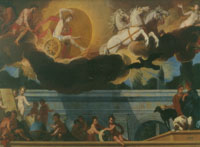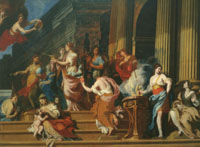

In the allegorical scheme devised for the Hall of the Planets the Sun is central and its representation is far larger than that of the other planets. In this it differs from SOL, the first stage of Sentence of the Gods. In design, however, it is similar, for just as the “S” of SOL (the Roman sun god) stands for Sleep, the epic’s first, largely oneiric, book, so in the Eggenberg allegory we find an old man in a somnolent pose behind the strong figure of middle age who pushes the solar chariot and the youthful figure who drives it. The second of these figures might be seen as corresponding to O, the second book in SOL and whose poems represent the daytime. (Note here the coincidentally elliptical form of the sun in the Eggenberg painting and its similarity to the title of the second book in the Sentence.)
Barbara Kaiser has given us a detailed commentary on the Eggenberg representation: “The sun god steers his golden chariot and urges on the fiery stallions as they commence their steep ascent to the highest point of heaven. The midday heat, breathing fire, and Aurora, the Dawn, pouring dew over the earth, fly ahead of him. On earth a whole host of virtues has come together in front of antique palaces to watch the sunrise. From their midst an eagle rises toward the sun. Beneath the dark clouds that carry the chariot, cherubs are playing with mathematical and astronomical instruments: sun-dial, compass, globe and planetary circle.” She goes on to offer extensive comments under the headings “Myth,” “The Planet,” “The Center,” and “The New Golden Age” to flesh out and explicate the allegory.
See Barbara Kaiser and Ulrich Becker, Schloss Eggenberg, trans. A. and A. Preston (Vienna: Christian Brandstätter Verlag, 2006) for commentaries on all seven planets.